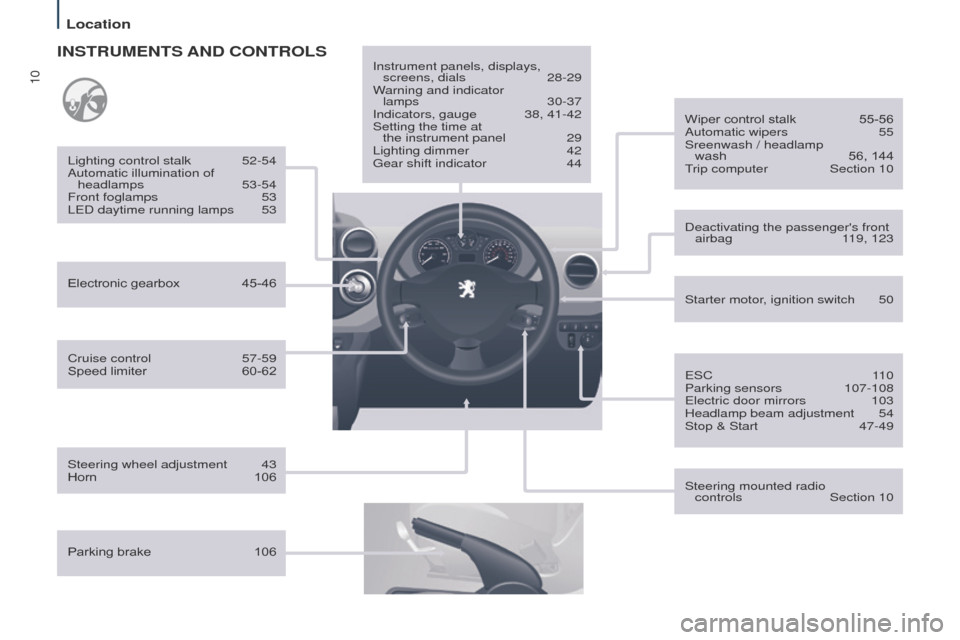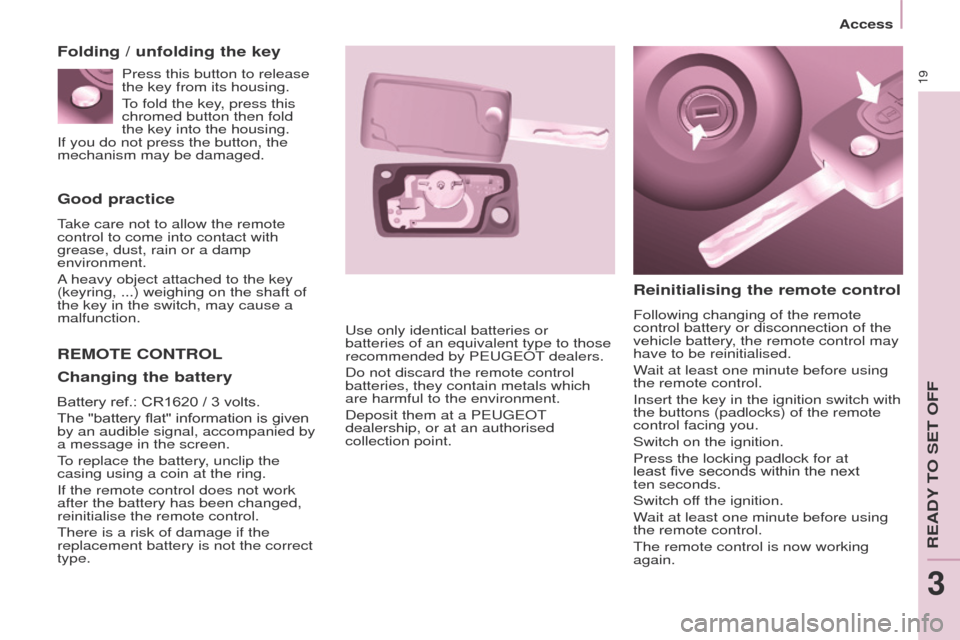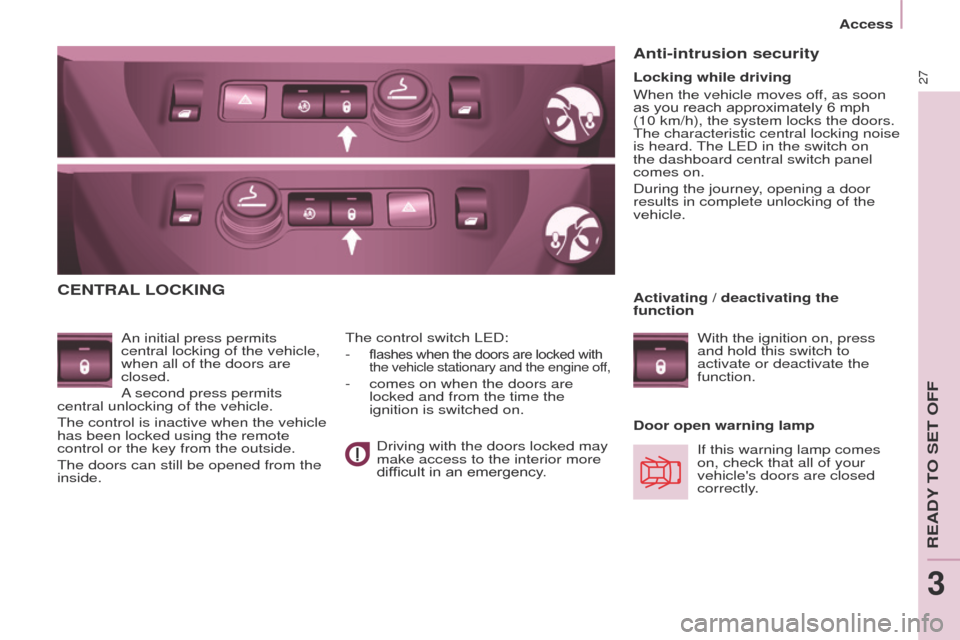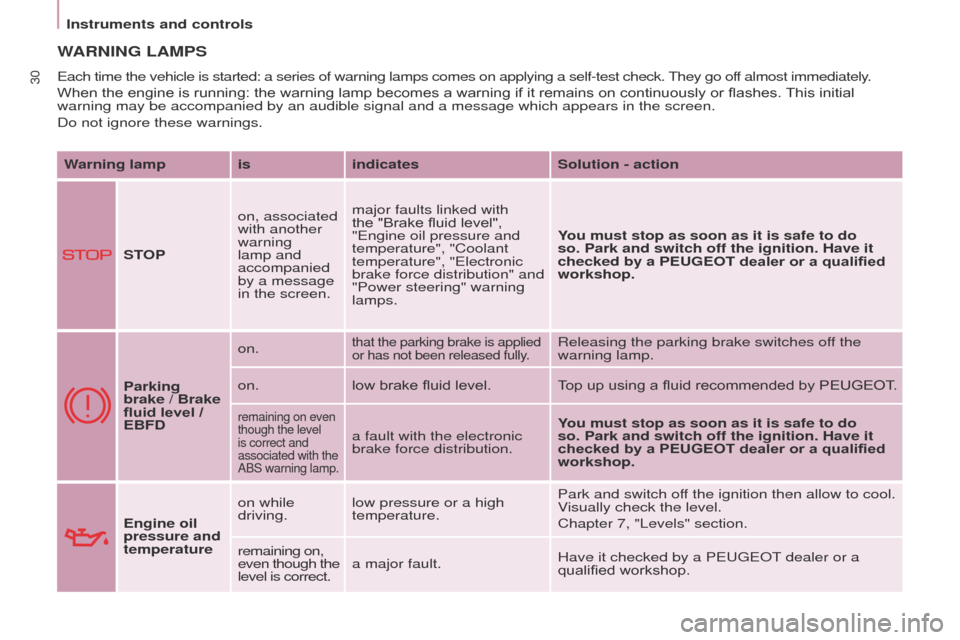ignition Peugeot Partner Tepee 2015 Owner's Manual
[x] Cancel search | Manufacturer: PEUGEOT, Model Year: 2015, Model line: Partner Tepee, Model: Peugeot Partner Tepee 2015Pages: 276, PDF Size: 12.76 MB
Page 10 of 276

8
Partner_2_VP_en_Chap01_vue-ensemble_ed02-2014
eSC 110
Parking sensors 107-108e
lectric mirrors
103Headlamp beam height adjustment 54
Stop & Start
47-49
Cruise control
57-59
Speed limiter
60-62
Lighting controls
52-54
Automatic illumination of headlamps
53-54
Foglamps
53
L
e
D daytime running lamps
53
INSTRUMENTS AND CONTROLS
Dashboard, passenger
compartment fuses 173-175
Opening the bonnet
140
Parking brake
106 Instrument panels, screens,
dials 28-29
Warning lamps, indicator lamps 30-37
Indicators, fuel gauge
38, 41-42
Setting the time in
the instrument panel
29
Lighting dimmer
42g
ear shift indicator
44
Ignition switch
50
Electronic gearbox
45-46
Wiper controls
55-56
Automatic rain sensitive wipers
5
5
Screenwash / headlamp wash 56, 144trip computer
Section 10
Audio equipment steering mounted controls
Section 10
Steering wheel adjustment
43
Horn
103
Location
Page 12 of 276

10
Partner_2_VP_en_Chap01_vue-ensemble_ed02-2014
Cruise control 57-59
Speed limiter 60-62
Lighting control stalk
52-54
Automatic illumination of headlamps
53-54
Front foglamps
53
L
e D daytime running lamps
53
INSTRUMENTS AND CONTROLS
Parking brake 106Instrument panels, displays,
screens, dials
28-29
W
arning and indicator
lamps
30-37
Indicators, gauge
38, 41-42
Setting the time at
the instrument panel
29
Lighting dimmer
42g
ear shift indicator
44
Steering wheel adjustment
43
Horn
106 Starter motor
, ignition switch
50
Wiper control stalk
55-56
Automatic wipers
55
Sreenwash / headlamp
wash
56, 144trip computer
Section 10
Steering mounted radio
controls
Section 10
Deactivating the passenger's front
airbag
1
19, 123
e
SC
1
10
Parking sensors
107-108e
lectric door mirrors
103
Headlamp beam adjustment
54
Stop & Start
47-49
Electronic gearbox
45-46
Location
Page 15 of 276

13
Partner_2_VP_en_Chap01_vue-ensemble_ed02-2014
INSTRUMENTS AND CONTROLS
1. Lighting and direction indicator
stalk.
2.
Instrument panel with screen.
3.
Wipers, screenwash, trip
computer control stalk.
4.
Ignition.
5.
Audio system controls.
6.
Driver's front airbag, horn.
7.
Steering wheel height and reach
adjustment.
8.
Cruise control, speed limiter
controls.
9.
Switch panel, parking sensors,
headlamp beam adjustment,
e
SC, Stop & Start.
10.
Bonnet
release.
11 .
e lectric door mirror adjustment.
12.
e lectric window switches.
13.
Switch panel: hazard warning
lamps, central locking, child lock.
14.
Cigarette
lighter.
15.
Heating-ventilation
controls.
16.
Storage
compartment.
17.
e lectronic gearbox controls or
g
rip control.
18.
Audio
equipment.
19.
Screen.
20.
e mergency or assistance call.
1
OVeRVIeW
Presentation
Page 16 of 276

14
Partner_2_VP_en_Chap01_vue-ensemble_ed02-2014
INSTRUMENTS AND CONTROLS
1. Lighting and direction indicator
control stalk.
2.
Instrument panel with screen.
3.
Wiper
, screenwash, trip
computer control stalk.
4.
Ignition switch.
5.
Audio system controls.
6.
Driver's front airbag, horn.
7.
Steering wheel height and reach
adjustment.
8.
Cruise control, speed limiter
controls.
9.
Switch panel, parking sensors,
headlamp beam adjustment,
e
SC, Stop & Start, alarm.
10.
Bonnet release lever
.
11 .
e lectric door mirror controls.
12.
e lectric window switches.
13.
Switch panel: hazard warning,
central locking, child lock.
14.
Cigarette
lighter.
15.
Heating-ventilation
controls.
16.
Door
pockets.
17.
e lectronic gearbox controls or
g
rip control.
18.
Audio
system.
19.
Screen.
20.
e mergency or assistance call.
Presentation
Page 21 of 276

19
Partner_2_VP_en_Chap03_Pret-a-partir_ed02-2014
Good practice
take care not to allow the remote
control to come into contact with
grease, dust, rain or a damp
environment.
A
heavy object attached to the key
(keyring, ...) weighing on the shaft of
the key in the switch, may cause a
malfunction.
REMOTE CONTROL Reinitialising the remote control
Following changing of the remote
control battery or disconnection of the
vehicle battery, the remote control may
have to be reinitialised.
Wait at least one minute before using
the remote control.
Insert the key in the ignition switch with
the buttons (padlocks) of the remote
control facing you.
Switch on the ignition.
Press the locking padlock for at
least five seconds within the next
ten
seconds.
Switch off the ignition.
Wait at least one minute before using
the remote control.
t
he remote control is now working
again.u
se only identical batteries or
batteries of an equivalent type to those
recommended by P
euge
O
t
dealers.
Do not discard the remote control
batteries, they contain metals which
are harmful to the environment.
Deposit them at a P
euge
O
t
dealership, or at an authorised
collection point.
Folding / unfolding the key
Changing the battery
Battery ref.: CR1620 / 3 volts.
The "battery flat" information is given
by an audible signal, accompanied by
a message in the screen.
to replace the battery
, unclip the
casing using a coin at the ring.
If the remote control does not work
after the battery has been changed,
reinitialise the remote control.
t
here is a risk of damage if the
replacement battery is not the correct
type. Press this button to release
the key from its housing.
to fold the key
, press this
chromed button then fold
the key into the housing.
If you do not press the button, the
mechanism may be damaged.
Access
ReADY tO Set OFF
3
Page 22 of 276

20
Partner_2_VP_en_Chap03_Pret-a-partir_ed02-2014
When leaving the vehicle, check that
the lamps are off and nothing of value
is visible.
As a safety precaution (with children
on board), remove the key from the
ignition when leaving the vehicle, even
for a short time.
Good practice
Do not make any modifications to the
electronic immobiliser system.
Operating the remote control, even
when it is in your pocket, may result in
involuntary unlocking of the doors.
t
he simultaneous use of other
high frequency equipment (mobile
telephones, domestic alarms…), may
interfere with the operation of the
remote control temporarily.
t
he remote control does not operate
while the key is in the ignition, even if
the ignition is off.
ELECTRONIC IMMOBILISER
All of the keys contain an electronic
immobiliser device.
t
his device locks the engine supply
system. It is activated automatically
when the key is removed from the
ignition.
After the ignition is switched on, a
dialogue is established between the
key and the electronic immobiliser
system.
t
he metal part of the key must be
unfolded correctly for correct dialogue
to take place.
If you lose your keys
Visit a P
euge O t
dealer with the
vehicle's V5 registration document and
your identification document.
A
P euge O t
dealer will be able
to retrieve the key code and
the transponder code so that a
replacement key can be ordered. When purchasing a second-hand
vehicle:
-
have the keys memorised by a
P
euge O t
dealer to ensure that
the keys in your possession are
the only ones which can start the
vehicle.
ALARM
If fitted on your vehicle, this provides
two types of protection:
-
exterior protection: it sounds if a
front/rear door or the bonnet is
opened.
-
interior protection: it sounds if
the volume inside the passenger
compartment changes (breaking of
a window or a movement inside the
vehicle).
If
your vehicle is fitted with a separation
partition, the interior protection is not
active in the load space.
Locking the vehicle with
complete alarm
Setting the alarm
- Switch of f the ignition and get out of
the vehicle.
-
Set the alarm within five minutes of
getting out of the vehicle, by locking
or deadlocking using the remote
control.
t
he red L e D, located in the
button, flashes once per second.
Access
Page 23 of 276

21
Partner_2_VP_en_Chap03_Pret-a-partir_ed02-2014
FRONT DOORS
From the inside
use the door opening control to unlock
and open the door concerned.
From the outside
use the remote control to lock/unlock
the vehicle.
Insert the metal part of the key in the
lock on the driver's side if the remote
control does not work.
Disarming
- unlock the vehicle with the remote
control or switch on the ignition, the
red L
e D goes off.
Locking the vehicle with
exterior protection only
If, while you are away from the
vehicle, you wish to leave a window
partially open or a pet inside the
vehicle, you should choose exterior
protection only.
-
Switch of
f the ignition.
-
In the next ten seconds,
press the button until
the red L
e D is on
continuously.
-
g et out of the vehicle.
-
Within the next five minutes, set
the alarm by locking or deadlocking
using the remote control (the red
LED flashes once a second).
Triggering
the siren sounds, the direction indicators
flash for approximately 30 seconds and
the red LED flashes rapidly.
-
t
o switch it of
f, insert the key and
switch on the ignition.
When the alarm has been triggered ten
times in succession (when triggered for
the eleventh time) it is deactivated. Repeat
the procedure for setting the alarm.
Locking the vehicle without
alarm
- Insert the key in the lock on the
driver's door and lock it.
Do not set the alarm when washing
your vehicle.
Failure of the remote control
When the alarm is set but the remote
control does not operate:
-
u nlock the doors with the key and
open the door.
t
he alarm is triggered.
-
Switch on the ignition in the next
ten
seconds.
t
he alarm is disarmed.
Incorrect operation
When the ignition is switched on, if the
red Le D remains on for ten seconds,
there is a fault in the siren connection.
Contact a P
euge O t
dealer to have
the system checked.
Automatic setting of the alarm
Depending on the country in which
the vehicle is sold, the alarm is set
automatically approximately 2 minutes
after the last door is closed.
to prevent triggering of the alarm when
a door is opened, you have to press
the remote control unlocking button
again.
Do not make any modifications
to the alarm system as this could
cause faults.
Access
ReADY tO Set OFF
3
Page 29 of 276

27
Partner_2_VP_en_Chap03_Pret-a-partir_ed02-2014
CENTRAL LOCKING
An initial press permits
central locking of the vehicle,
when all of the doors are
closed.
A second press permits
central unlocking of the vehicle.
t
he control is inactive when the vehicle
has been locked using the remote
control or the key from the outside.
t
he doors can still be opened from the
inside. Door open warning lampt
he control switch L e D:
-
flashes when the doors are locked with
the vehicle stationary and the engine off,
- comes on when the doors are
locked and from the time the
ignition is switched on.
Anti-intrusion security
If this warning lamp comes
on, check that all of your
vehicle's doors are closed
correctly.
Locking while driving
When the vehicle moves off, as soon
as you reach approximately 6 mph
(10 km/h), the system locks the doors.
t
he characteristic central locking noise
is heard.
t
he L e D in the switch on
the dashboard central switch panel
comes
on.
During the journey, opening a door
results in complete unlocking of the
vehicle.
Activating / deactivating the
function
With the ignition on, press
and hold this switch to
activate or deactivate the
function.
Driving with the doors locked may
make access to the interior more
difficult in an emergency.
Access
ReADY tO Set OFF
3
Page 32 of 276

30
Partner_2_VP_en_Chap03_Pret-a-partir_ed02-2014
WARNING LAMPS
each time the vehicle is started: a series of warning lamps comes on appl\
ying a self-test check. t hey go off almost immediately.
When the engine is running: the warning lamp becomes a warning if it remains on continuously or flashes. This initial
warning may be accompanied by an audible signal and a message which appe\
ars in the screen.
Do not ignore these warnings.
Warning lamp is indicatesSolution - action
STOP on, associated
with another
warning
lamp and
accompanied
by a message
in the screen.major faults linked with
the "Brake fluid level",
"
e ngine oil pressure and
temperature", "Coolant
temperature", "
e lectronic
brake force distribution" and
"Power steering" warning
lamps. You must stop as soon as it is safe to do
so. Park and switch off the ignition. Have it
checked by a PEUGEOT dealer or a qualified
workshop.
Parking
brake
/ Brake
fluid level /
EBFD on.
that the parking brake is applied
or has not been released fully.Releasing the parking brake switches off the
warning lamp.
on. low brake fluid level. Top up using a fluid recommended by PEUGEOT.
remaining on even
though the level
is correct and
associated with the
ABS warning lamp.
a fault with the electronic
brake force distribution. You must stop as soon as it is safe to do
so. Park and switch off the ignition. Have it
checked by a PEUGEOT dealer or a qualified
workshop.
Engine oil
pressure and
temperature on while
driving.
low pressure or a high
temperature. Park and switch off the ignition then allow to cool.
Visually check the level.
Chapter 7, "Levels" section.
remaining on,
even though the
level is correct. a major fault.
Have it checked by a P
euge O t
dealer or a
qualified workshop.
Instruments and controls
Page 33 of 276

31
Partner_2_VP_en_Chap03_Pret-a-partir_ed02-2014
Warning lamp isindicatesSolution - action
Coolant
temperature
and level on with needle
in the red
zone.
an abnormal increase in
temperature.
Park and switch off the ignition then allow to cool.
Visually check the level.
flashing. a drop in the coolant level. Chapter 7, "Levels" section.
Contact a PEUGEOT
dealer or a qualified
workshop.
Service on temporarily. minor faults or warnings.
Consult the alert log in the display or screen.
If your vehicle is equipped with a trip computer
or a screen: refer to the "Audio equipment -
trip
computer" section of chapter 10.
Contact a PEUGEOT
dealer or a qualified
workshop.
remaining on. major faults.
Seat belt not
fastened on then
flashing.
the driver and/or front
passenger has not fastened
their seat belt.
Pull the strap then insert the tongue in the buckle.
accompanied
by an audible
signal then
remains on. the vehicle is moving with
the driver's and/or front
passenger's seat belt not
fastened.
Check that the seat belt is fastened by pulling the
strap.
Chapter 5, "Seat belts" section.
ECO on.
t
he Stop & Start system
has put the engine in
S
t
OP
mode following a
vehicle stop (red light, traffic
jam,
etc...).As soon as you want to move off, the warning
lamp goes off and the engine restarts
automatically in S
t
ARt mode.
flashes for a
few seconds,
then goes of
f.S
t
OP
mode is temporarily
unavailable.
or
S
t
ARt mode has been
invoked automatically
.Chapter 3, "Stop & Start" section.
Instruments and controls
ReADY tO Set OFF
3